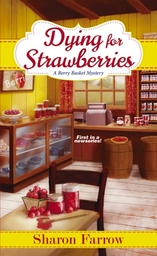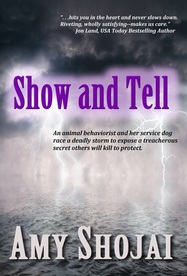|
There is a long tradition of authors using pseudonyms or writing under Anonymous, and I'm always curious about what makes someone wish to write under someone else's name. I asked Sharon Pisacreta to join me on my blog today, to discuss why she uses pseudonyms (FOUR!) and how she chose them. Her first book in a new series, DYING FOR STRAWBERRIES, will be released November 1, 2016.  Along with spies and people in the witness protection program, authors often feel compelled to change identities. My upcoming mystery series will be released under ‘Sharon Farrow’. It will be the fourth name I’ve used as an author. When my stories and articles first began to appear in magazines, I proudly used the name I was born with. Although it was a tricky Italian name that few non-Italians could pronounce, it made my family happy. However I learned that Shakespeare’s question “What’s in a name?” has special meaning for authors. After I sold my first novel, I thought I’d make things easier for my readers and decided on ‘Sharon Kirk’ as a pseudonym (yes, I’m a Trekkie). Unfortunately, someone in production forgot to read my contract and released that first book under my Italian name. Two other books followed, accompanied by numerous calls from my publisher asking how to pronounce ‘Pisacreta’. Sales reps ran into problems with my name when speaking with distributors. One of my novels was sold as part of a six-book package on the Home Shopping Network, eliciting more questions on exactly how the TV host should say my name. My editor finally asked if I would mind taking a pseudonym. I was happy to oblige. This time I went with ‘Cynthia Kirk’. It sounded British, elegant, and impossible to mispronounce. Soon after, I put aside novel writing and returned to magazine work under my maiden name. I got back in the novel writing game when a friend and fellow author convinced me to team up with her on a mystery series. Because our previous novels were in the romance and western genres, we needed a pen name for our historical mystery series. Marketing is everything in publishing, and an author’s name is a form of branding. If readers want to buy your mystery novel, they don’t want to be confused if you also write science fiction under the same name. We wanted an easy name to spell and remember. The result was D.E. Ireland. Since our series is based on Shaw’s Pygmalion and stars Eliza Doolittle, we chose her initials, transposing them for our first name. Ireland was selected because George Bernard Shaw was born and raised in Dublin. As a writing team, a pen name seemed necessary. Few teams publish under one of the pair’s real name. A notable exception is the Ian Rutledge mystery series by Charles Todd, written by Charles and his mother Caroline. Normally, a new pseudonym is created for the duo, such as Alice Alfonsi and husband Marc Cerasino who write as ‘Cleo Coyle’. All writers should keep a few pen names in their back pocket. If you’re prolific, publishers don’t want to flood the market with too any books under one name in the same year. Because Dean Koontz sometimes published eight books a year, he wrote under eleven different names. Famous authors may feel constrained by their success and want to try something new under a pseudonym. J.K. Rowling writes mystery novels as Robert Galbraith, Stephen King’s alter ego is Richard Bachman. When Anne Rice switched from vampires to erotica, she did so under two pen names. And prolific romance author Nora Roberts chose to write as J.D. Robb for her futuristic mysteries. Because mysteries are so popular, many authors meet demand by writing more than one series under different names. Vicki Delaney writes cozies and suspense novels under both the pseudonym Eva Gates and her own name. Eva K. Sandstrom uses the pseudonym JoAnna Carl for her long running Chocoholic series. Some authors simply prefer using a pseudonym. Janet Quin-Harkin became Rhys Bowen. Juliet Marion Hulme writes as Anne Perry. As we did with D.E. Ireland, choosing a gender neutral pen name also helps attract male readers not prone to buying novels by women. Famous examples include Marion McChesney Gibbons writing as M.C. Beaton, and Edith Mary Pargeter as Ellis Peters. A publisher might also insist on a pseudonym if books written under a previous name had lackluster sales. They often feel it is best to start fresh with a new writing identity. Whether it’s due to a difficult name to pronounce, being too prolific, a poor sales record, switching genres, a writing collaboration, or a desire to conceal your gender, taking on a pseudonym is always an adventure. Finally, writing under a pen name provides a measure of anonymity – and a bit of welcome distance. A bad review directed at books written under your real name cuts a little sharper than one aimed at one written under a pseudonym. It may sound odd, but it’s true. That alone may be worth a name change.  Sharon Farrow writes The Berry Basket Mysteries set in Oriole Point, Michigan. The first book in the series, DYING FOR STRAWBERRIES, will be released on November 1, 2016. While this is her debut as ‘Sharon Farrow’, she wrote romance novels under both ‘Sharon Pisacreta’ and ‘Cynthia Kirk’. In 2013, she took on another pseudonym as one half of the writing duo, ‘D.E. Ireland’, the Agatha Award nominated authors of the Eliza Doolittle/Henry Higgins mystery series.
2 Comments
I'm joined on my blog today by Amy Shojai, author of the recently released Show and Tell. Because Amy is an expert on pet care and animal behavior and writes dog-viewpoint thrillers, I asked her to speak about what she had learned about writing pets into fiction.  I love reading stories that incorporate animals in a believable fashion, but far too many authors insert pet characters for the wrong reason—or fail to execute in a believable fashion. Reading fiction is all about a suspension of disbelief, and a large percentage of avid readers also love pets. About 65 percent of US Households have a pet—that’s a lot of potential book buyers! The trick, of course, is making your “talking cat” or “thinking dog” so natural that readers accept this ability as fact within your story world. The really avid pet parents already have opinions and insight into how cats and dogs act, and aren’t forgiving of missed paw-steps. PETS AS PROPS. Writers often give the hero a pet to make them more likable, or they’ll have the villain kill an animal to illustrate an unsympathetic character. Most pet-loving readers object to critter-killing simply for shock value. When pets appear in the first chapter and last, with no mention in between, pet lovers recognize this as artificial manipulation. When your hero’s call to action leaves the cat/dog alone at home for weeks, readers wonder why the house isn’t full of crappiocca and hissed-off pets when s/he returns. Please, for the love of doG (and cat), create a character’s relationship with the pet, which builds character depth and reader engagement. TALKING PETS. How your animal characters interact with the humans depends a great deal on the genre and what readers expect. Fantasy’s shape-shifters certainly may have all kinds of critters thinking and speaking the same as the human characters, and many children’s books use anthropomorphized characters to advantage. Based on your story, genre, and reader expectations, decide whether your animals will be “humans in fur coats” or true to their species. Mysteries today are full of talking dogs and cats, and the successful series make clear that these critters have both species-appropriate “extra” skills and limitations. In my September Day series, service dog Shadow has his own viewpoint chapters. He never says a word, yet speaks volumes. GOALS & REWARDS. When creating an animal viewpoint character, go beyond the gift of speech or tail semaphore. Just as your hero and villain require opposing story goals and motivations to fuel the plot, give your pet character reasons to care. Shadow’s story goal and motivation is quite different than his human partner September, and he’s able to offer an enriched reader experience through his enhanced senses. Because of my background as a certified animal behavior consultant, I wanted Shadow to act and react, communicate and feel emotion in a true reflection of the canine species I know (with a bit of fiction speculation). For me, that’s not just a plot device but shows respect for these unique creatures. Shadow has his own character arc in each book. He is not the same clueless nine-month-old puppy that began the series, and has grown and developed alongside his human partner September with each new story. One caution: when writing a series, be aware of the timeline, because pets age much more quickly than human characters. I don’t what Shadow to “age out” of the series too quickly, so the first book LOST AND FOUND happens at Thanksgiving, the second one HIDE AND SEEK follows at Christmas, and now SHOW AND TELL takes place right after Valentine’s Day. Today, pets are considered to be members of the family, in some cases surrogate children. People read for entertainment, for the spills and thrills and tug-at-the-heart rooting for the underdog human—or pet. So adding a furry character to a book, when done well, enhances the reader experiences and gives everyone an extra emotional tug. September and Shadow have just begun their life together, and have many more adventures to come!  Amy Shojai is a nationally known authority on pet care and behavior, a certified animal behavior consultant, a spokesperson for the pet products industry, and the author of 30+ nonfiction pet books. She also writes THRILLERS WITH BITE! which includes the dog-viewpoint thrillers LOST AND FOUND, HIDE AND SEEK, and SHOW AND TELL. Amy can be found on Facebook http://www.facebook.com/amyshojai.cabc, on Twitter @amyshojai, and on Pinterest @amyshojai. Check out her website at http://www.shojai.com. |
Susanna CalkinsHistorian. Mystery writer. Researcher. Teacher. Occasional blogger. Categories
All
Archives
May 2023
|
 RSS Feed
RSS Feed